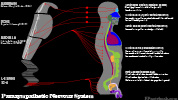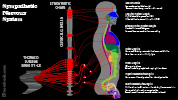II. Definitions
- Autonomic Nervous System
- System of internal regulation for times of both rest (parasympathetic) and stress (sympathetic)
- Coordinates organ function (e.g. Heart Rate, Respiratory Rate, sweating and crying, urination and stooling)
- Hypothalamus regulates the Autonomic System via both direct Neuron connections, as well as hormonal release
III. Anatomy: General
- Autonomic System operates in parallel to the somatic system (motor, sensory)
- Central control (especially Hypothalamus and solitary nucleus) based on peripheral visceral afferent signals
- Autonomic Pathways are primarily two Neuron (preganglionic, postganglionic)
- Regulates involuntary actions
- Smooth Muscle and cardiac Muscle
- Cardiopulmonary system
- Gastrointestinal System
- Glands (e.g. lacrimal, Salivary, sweat)
- Smooth Muscle and cardiac Muscle
IV. Anatomy: Parasympathetic and Sympathetic Systems
- Parasympathetic and Sympathetic Systems typically counter one another with opposing actions
- Some activities (e.g. sexual arousal) involve both systems (Erection is parasympathetic, ejaculation sympathetic)
-
Parasympathetic Nervous System
- Signals originate in the Sacral spinal cord (S2 to S4) and Brain Stem nucleii (CN 3, CN 7, CN 9, CN 10)
- Parasympathetic Ganglions are close to the organs and glands they innervate
- Energy conserving (anabolic) system activated in rest and relaxation situations ("housekeeping" functions)
- Decreases Heart Rate, Blood Pressure and pupil size (Miosis)
- Stimulates gastrointestinal activity, Salivary secretion and urinary contraction
- Images
- Signals originate in the Sacral spinal cord (S2 to S4) and Brain Stem nucleii (CN 3, CN 7, CN 9, CN 10)
-
Sympathetic Nervous System
- Signals originate in the spinal cord intermediolateral column (T1 to L2)
- Energy expending (catabolic) system, activated in stressful situations (e.g. emergency fight or flight)
- Increases Heart Rate, Blood Pressure, Respiratory Rate and pupil size
- Shunts Blood Flow to critical organs (cardiac and skeletal Muscle) from Gastrointestinal Tract
- Images
V. Anatomy: Preganglionic and Postganglionic Fibers
- Preganglionic Neuron (CNS to autonomic Ganglion)
- Acetylcholine mediated (Cholinergic) in both sympathetic and Parasympathetic Systems
- Postganglionic Neuron (autonomic Ganglion to target organ)
- Parasympathetic System: Acetylcholine mediated (Cholinergic) as with preganglionic fibers
- Sympathetic System: Norepinephrine mediated (with exceptions, such as Acetylcholine for sweating)
- Images
VI. Pathophysiology
VII. References
- Goldberg (2014) Clinical Neuroanatomy, Medmaster, p. 54-60
- Netter (1997) Atlas Human Anatomy, ICON Learning, p. 152-4



